One of Barbara Bosworth’s most prized possessions is a collection of bird eggs she inherited from her great-grandfather, who collected them in the wild, blew out their interiors, and saved the shells in a shirt box his mother gave him. “I’m so influenced by the Victorians,” says Bosworth. “They went out and collected. That’s how they learned.” (Despite her admiration, Bosworth is careful to add that she does not condone the Victorians’ extractive exploits. “I don’t think that’s appropriate anymore,” she says. “We can learn things differently.”)
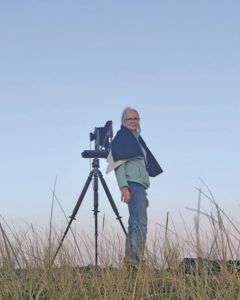
She learns about the world herself through her large-format camera and the occasional foraging of objects and samples from around the world. Bosworth’s most recent book, The Sea, hearkens to the 19th century in both the artist’s use of an antique camera and a collector’s sensibility that runs throughout the project.
Bosworth’s photographs read like poetic records of the natural world and are organized in groups, each introduced by a short text. Many of them were taken near Newcomb Hollow Beach in Wellfleet. Shot from the shoreline over the course of a few decades, they represent collected moments of time, weather, and light.
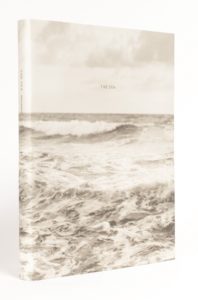
An excerpt from Virginia Woolf’s The Waves introduces the first group of photographs. Woolf’s ornate description of waves that “swept the beach with steel blue and diamond-tipped water” recalls a black-and-white photograph in which the frothy surface of the ocean spreads out like lace. Margot Anne Kelley’s essay “Litoral Life” looks at the ecosystem of intertidal zones, including clam diggers, beachgoers, and periwinkles. Likewise, in the accompanying photographs, Bosworth turns her attention to the human presence along the shoreline: a sandcastle, sport fishermen, cottages. The photographs are not illustrations of the text; instead, they converse with the vision and sensibilities of the four authors. “I wanted other things in there besides just my photographs,” says Bosworth.
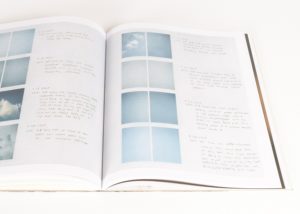
In addition to the literary excerpts, Bosworth included an appendix at the end of the book: “I tucked in these other things that I love,” she says. They include an essay about seabirds on the coast of Ireland and Wales; watercolors by J.M.W. Turner; a glossary of sea terms; scanned covers of nature guidebooks; a weather journal from a week in Wellfleet; and pictures of her sand collection. There are also family relics: watercolors by her grandfather; a short essay about a forgotten nautical term by her cousin (and Wellfleet resident) Richard Bailey; two photographs of Wellfleet Bay that she took as a child; and — perhaps most touching — a black sheet of paper, faded except for the areas where her mother had placed shells atop it to display her collection.
The overall effect is a multi-layered exploration that feels like a cabinet of curiosities or a small, quirky museum in miniature. Its looseness makes space for the poetic and the unexpected. But although it’s fluid and general in nature, the book is best approached by reading and looking at it from beginning to end in one sitting to appreciate its masterful structure and pacing, achieved through an ordering of visual and literary elements and shifts in the tactile qualities of different paper. Designed by David Chickey and Mat Patalano at Radius Books, it’s a curated work of art, not merely a documentation of artworks.
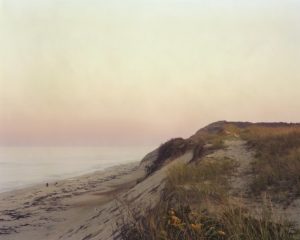
Although Bosworth is originally from Ohio, both of her parents had family in Wellfleet whom they would visit during summer vacations. Bosworth moved in the 1980s to Boston, where she became a professor of photography at Mass. College of Art and Design and began to visit Wellfleet more regularly. The book reflects her personal connection with the Outer Cape yet is universal in scope. Bosworth includes photographs from Florida and the West Coast, and throughout the book the personal intersects with the scientific and cosmological.

The book includes a photograph that Bosworth took as a child of her family swimming in Wellfleet Bay. “I love that picture,” she says. “My brother passed away this year, so it was a nice picture to have of him in there.” (Bosworth’s brother Ronald, a long-time Wellfleet resident, died last April.) The sea becomes not just a place for Bosworth to locate family memories but also to reflect on one’s mortality.
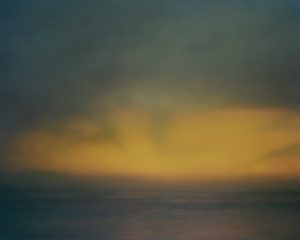
The Sea ends with a section called “Elsewhere,” which contains photographs that Bosworth made mostly in Florida the year her father died. Their hazy, colorful atmospheres, nearly abstract at times, were achieved through her use of a slow shutter speed. Each photograph in the section is printed on light matte paper and fills a two-page spread. They are immersive in both their presentation and imagery.
“I think about loved ones that are elsewhere,” says Bosworth. “I was going after that space where the Earth and the heaven realms blend and become this elsewhere.”



